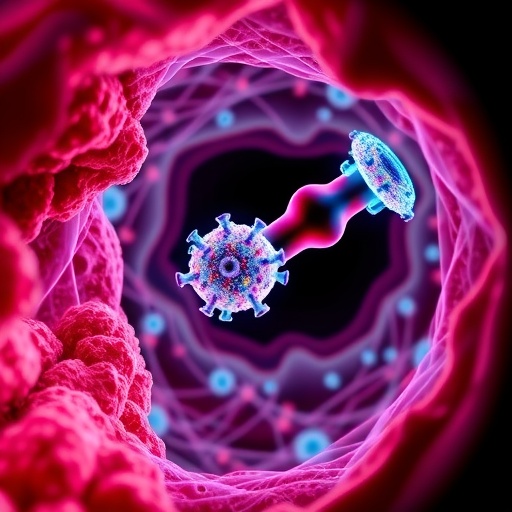In a groundbreaking development poised to redefine oncological diagnostics and therapeutics, an international team of researchers has unveiled an innovative project named MULTIPROBE. This avant-garde initiative involves the creation of hybrid endoscopes that seamlessly integrate high-resolution diagnostic imaging with cutting-edge, non-thermal therapeutic technology. Spearheaded by distinguished institutions including the Università Cattolica del Sacro Cuore in Rome, the Fondazione Universitaria Policlinico Agostino Gemelli IRCCS, Sapienza Università di Roma, and the University of Limoges in France, MULTIPROBE has garnered prestigious funding through the European Research Council’s ERC Synergy Grant 2025, earmarking over six million euros for a four-year research endeavor.
At its core, MULTIPROBE aims to surmount existing limitations in gastrointestinal (GI) endoscopy by harnessing a theragnostic approach—a paradigm that concurrently diagnoses and treats tumors in real time during endoscopic procedures. The existing gold standard for cancer diagnosis involves histopathological examination of biopsied tissue, a process that is both time-consuming and expensive, often delaying critical treatment initiation. The need for a rapid, reliable, and less invasive alternative has catalyzed the development of optical biopsy techniques, which derive tissue pathology insights from optical signals captured during endoscopic visualization, eliminating the wait associated with traditional biopsies.
The crux of the MULTIPROBE technological innovation lies in its hybrid endoscopes equipped with multimode optical fibers. These fibers are engineered to transmit multiple spectral bands of light, a feature that dramatically enhances image quality, spatial resolution, and contrast during live tissue examination. Unlike conventional fibers, the multimode fibers in MULTIPROBE exploit complex physical phenomena, like light condensation, to maintain beam stability and coherence even when subjected to physical stress such as bending—a common challenge in the dynamic environment within the human body. This ensures sharper, more informative images that empower clinicians with precise tissue characterization capabilities.
Simultaneously, the therapeutic facet of MULTIPROBE employs jets of cold atmospheric plasma—a non-thermal ionized gas capable of inducing apoptosis in cancer cells without causing thermal damage to surrounding healthy tissues. Unlike traditional thermal therapies, cold plasma selectively targets neoplastic cells, triggering programmed cell death while sparing the vasculature and lymphatic system. This selectivity mitigates adverse effects such as fibrosis or collateral tissue damage, substantially enhancing the safety profile of endoscopic treatment.
This holistic platform thus represents a quantum leap beyond current endoscopic practices, where diagnosis frequently necessitates a separate procedural step from treatment. By integrating real-time diagnostic imaging with immediate, localized plasma-based therapy, MULTIPROBE facilitates a seamless transition from tumor identification to eradication within a single session. This convergence of technologies promises substantial improvements in patient outcomes, procedural efficiency, and overall healthcare expenditures.
Leading experts involved in the project, including Professors Stefan Wabnitz of Sapienza University and Massimiliano Papi of Università Cattolica, emphasize the transformative potential of this approach in gastrointestinal oncology. Their vision encompasses not only early detection and treatment of GI cancers but also the extension of MULTIPROBE’s capabilities to other medical fields where real-time theragnostic interventions could be equally advantageous.
The technical prowess of the MULTIPROBE system lies in its exploitation of multimodal imaging modalities and adaptive optics, combining non-linear imaging techniques that generate highly detailed biological images while ensuring precise control of therapeutic plasma jets. This dual functionality, facilitated by the endoscopes’ miniaturized architecture, ensures minimally invasive access to internal pathological sites with unprecedented accuracy.
Moreover, the cold atmospheric plasma utilized in treatment is carefully controlled to optimize reactive species generation such as reactive oxygen and nitrogen species (ROS/RNS), which play vital roles in inducing selective cytotoxicity in cancer cells. These reactive species initiate a complex cascade of intracellular processes culminating in immunogenic cell death, thus potentially stimulating an anti-tumoral immune response alongside direct tumor ablation.
MULTIPROBE’s advances rely heavily on cutting-edge photonics and plasma physics principles, bridging fundamental science with translational medicine. The project’s multidisciplinary team fosters collaboration among physicists, gastroenterologists, engineers, and immunologists, each contributing expertise to tackle the multifaceted challenges inherent in real-time endoscopic theragnostics.
A critical milestone for MULTIPROBE will be the rigorous clinical validation of its integrated system, to ascertain reproducibility, safety, and diagnostic accuracy alongside the efficacy of plasma-based tumor ablation. Success in clinical trials could establish a new standard of care in GI cancer management, significantly streamlining patient workflows and enhancing therapeutic precision.
The implications of this innovation extend beyond gastrointestinal oncology, potentially revolutionizing the approach to other cancers and medical conditions where rapid, localized diagnosis and treatment are paramount. This could lead to an era in medicine where the boundaries between diagnosis and therapy dissolve, favoring real-time, targeted interventions that maximize patient benefits and minimize procedural burdens.
The MULTIPROBE project exemplifies the frontier of medical technology innovation—a synergistic fusion of optical engineering, plasma science, and clinical expertise. Its recognition by the European Research Council not only underscores the groundbreaking nature of the research but also highlights the importance of fostering multidisciplinary endeavors to address pressing healthcare challenges.
As the technology matures, the team envisions the eventual ubiquity of hybrid endoscopes worldwide, enabling clinicians to detect and treat gastrointestinal cancers with unparalleled efficiency and safety. Such advancements will empower physicians with potent new tools in the ongoing battle against cancer, enhancing survival rates and quality of life for countless patients globally.
Subject of Research: Theragnostic hybrid endoscopes integrating optical biopsy and cold plasma therapy for gastrointestinal cancer diagnosis and treatment
Article Title: MULTIPROBE: Revolutionizing Real-Time Cancer Diagnosis and Treatment with Hybrid Endoscopic Theragnostics
News Publication Date: Not specified
Web References: Not provided
References: Not provided
Image Credits: Not provided
Keywords: Cancer, gastrointestinal endoscopy, theragnostics, optical biopsy, cold atmospheric plasma, non-linear imaging, multimode optical fibers, real-time diagnosis, plasma therapy, minimally invasive treatment




